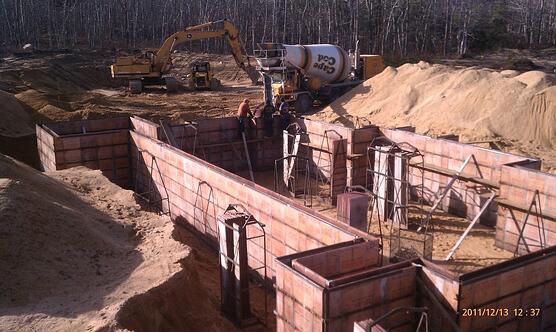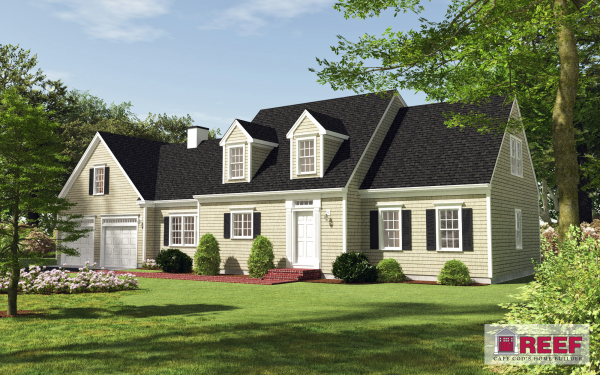
REEF is starting another new home in Dennis, MA!. This home is a custom designed, traditionally styled, cape with about 3,000sf of living area. Here are some photos of the foundation installation yesterday, along with a rendering of the finished product. Follow our blog to watch this project!!!

Tags:
New Homes Cape Cod,
new homes,
Cape Cod Builder,
home builder cape cod,
new construction,
builders cape cod
We have seen land prices fall somewhat over the last few years, and we can say with some certainty, that the prices are about as low as they are going to get. With the bottom of the market here, many people are thinking about purchasing a piece of land to build their new home. This is a great idea, given the economy, permitting environment, and favorable lending rates. However, there are some things you definitely want to think about before purchasing a piece of raw land.
- Get a Building Permit before you close on the property
- Understand all of the zoning, and other regulatory issues that apply to a certain property. (Historic, septic, conservation etc.)
- Make sure you can build what you want to build, where you want to build it on the lot. A good design/build contractor can help with this
- Find out about the cost of construction prior to committing to the purchase. What you think the house will cost you vs. what it will actually cost you may not be the same
- Find a team of professionals to help you. A good realtor, working with a competent design/build contractor like REEF can point you in the right direction, and assemble the other experts you will need.
Here is some additional information from about.com
http://homebuying.about.com/od/secondhomes/qt/102507_buyland.htm
Tags:
new homes,
Cape Cod Builder,
builder cape cod,
home plans,
buying land,
land
Did you know that the state of Massachusetts is currently considering mandatory fire sprinlker systems for homes? There has been a lot of debate about this issue over the last year or so. Arguments can be made for or against this requirement, but the bottom line is clear, it is another hurdle for builders, and adds unnecessary cost for the consumer. This proposed regulation will impact new construction and remodeling if it is approved. It is hard enough and expensive enough to build in this state as it is, let's not make it any harder. Here is some info from the Home Builder's Association of Massachusetts
http://hbama.com/archives/1881
Tags:
new homes,
renovation,
remodeling,
Cape Cod Builder,
builder cape cod
So this is one of my favorite times of the year, when everyone comes out with their predictions and evaluations on the best products, trends, and ideas in our business. Here is the 2011 product review by Architectural Record:
hhttp://archrecord.construction.com/products/productreports/2011.asp Now some of these products are not directly related to the residential construction, remodeling and renovation business. However, you will see these ideas translated into residential styles and trends over the next few years.
Tags:
new homes,
green construction,
Cape Cod Builder,
custom home,
builder cape cod,
residential construction
Given the fact that they are not making any more land here on Cape Cod, we are faced with the challenge of designing homes on very small lots. Most of our customers still want functional spaces, style, and all of the amenities of a large home, but in a smaller package. Here are some ideas for small spaces from This Old House that you might want to consider.
http://www.thisoldhouse.com/toh/small-home-space Also our Cottage Collection has a lot of these features in traditionally-styled homes
-Cottage Plans
Tags:
renovation cape cod,
Cape cod builders,
remodeling,
Cape Cod Builder,
house plans
Given the green construction trends, and building codes requiring higher energy efficiency, many customers consider a complete heating system upgrade as part of a major renovation or remodeling project. The Energy Star program provides a lot of good information and tips to improve your existing system, without a substantial cost... Click here to find out more.
http://www.energystar.gov/index.cfm?c=heat_cool.pr_hvac
Tags:
new homes,
renovation,
remodeling,
home improvements,
green construction
Most customers spend a lot of time and effort on getting their kitchen exactly right. But with the myriad of kitchen cabinets, countertops, plumbing fixtures and appliances on the market, the process can be overwhelming. We have found a team approach works best, coordinating the kitchen supplier, appliances sales team, and plumbing fixture supplier all together. Here is a link to the kitchen expert we rely on to make this happen.
http://atlantickitchenandbath.com/
Tags:
renovation,
remodeling,
home improvements,
custom home,
kitchen
Here are photos of a home we completed a few months ago in Harwich, MA. This house features stunning design, exceptional spaces, and REEF was proud to be a part of it!!!
http://www.facebook.com/media/set/?set=a.326370830721725.97238.319857238039751&type=3&l=55509206ad
Tags:
new homes,
remodeling,
Cape Cod Builder,
new construction,
REEF,
Harwich





